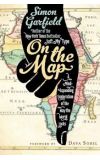
01 Oct 2013 06:27:19
My favourite living room – of those in my neighbourhood I can stare into – has old maps on the walls, which I find soothing and benign. But Simon Garfield, whose home is apparently similarly decorated, tells us that map-making has been a way of appropriating the world, a function of power, whether carried on in ancient Alexandria or the Google HQ. He cites a British map of Calcutta, produced in 1842 by the "ominously named" Society for the Diffusion of Useful Knowledge. Public buildings like banks and police stations are shown, but no temples or mosques. On the Map is peppered with such compelling and bizarre anecdotes, some to do with recurring cartographic howlers (because map makers, like cookery writers, copy one another). In 1622, a Spanish map depicted California as a big island off America. The mistake was repeated for decades, on maps hubristically entitled things like "A New and Most Exact Map of America" or "America Drawn from the Latest and Best Observations". And then there were the massive, yet nonexistent, west African "Mountains of Kong", which fitted in with some late 18th-century cartographer's pet theory about the source of the Nile, and which still appeared in an Oxford Advanced Atlas of 1928.
The chapter on the Ordnance Survey, that "cartographic Domesday book" begun in 1750, is beguiling, not least for Garfield's list of its map-making rules. ("Taps: taps on public drinking fountains will be shown." "Letterboxes: are mapped except when built into post offices.") He meets a stressed-out maker of globes: "Making anything round is just a nightmare." He tells us about the origins of the London A-Z, at the hands of the formidable Phyllis Pearsall, who may or may not have walked 23,000 London streets, but who certainly compiled an alphabetical card index of those streets. One day, all the Ts blew out of her window, which is why Trafalgar Square was accidentally omitted from the index on an early draft. With the advent of GPS, sales of the A-Z have gone "down and down".
Since concentrating on print culture (his previous book was on typefaces, his next will be about the mail) Garfield has hit bestselling form by chronicling what we could be losing. He writes that the victory of satnav is "a loss for geography, history, navigation, maps, human communication, and the sense of being connected to the world around us". But his tone is ever buoyant. With his pedagogic rhetorical questions ("How can we be sure they were forgeries?" "What, then, was the perceived problem?") Garfield is like the schoolteacher who made the time fly, a one-man Blue Peter team for intelligent adults, a great British explainer.

